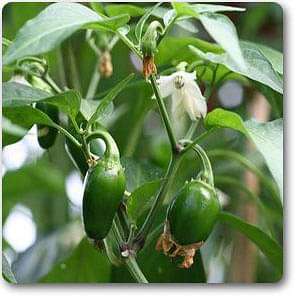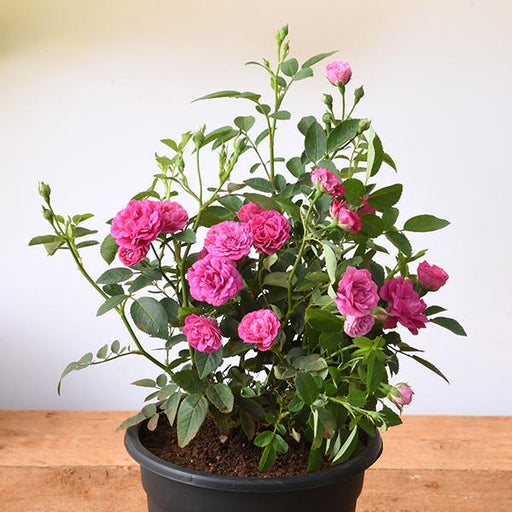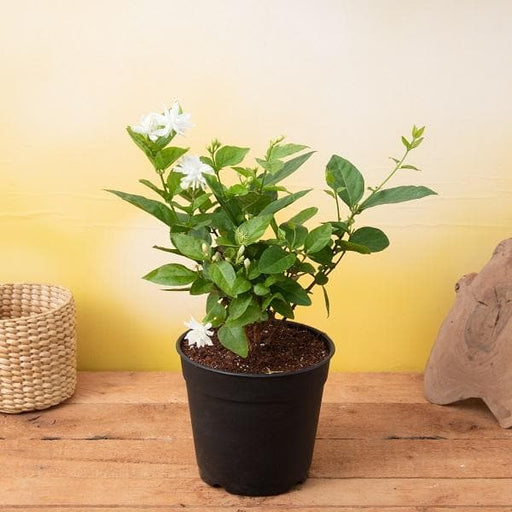
Ethiopian pepper - Plant
(MRP Inclusive of all taxes)
- Shipping ₹79 for entire order
- Dispatch in 7 days
- Country of origin: India

(MRP Inclusive of all taxes)
 Save 29%
Save 29%
Air Purifier Money Plant with Pot The Air Purifier Money Plant, also known as Pothos or Epipremnum aureum, is a stunning indoor plant that...
View full details
 Save up to 15%
Save up to 15%
Peace Lily, Spathiphyllum - Plant The Peace Lily, scientifically known as Spathiphyllum, is a stunning houseplant celebrated for its elegant white...
View full details
 Save 25%
Save 25%
Jasminum sambac, Mogra, Arabian Jasmine - Plant Jasminum sambac, commonly known as Mogra or Arabian Jasmine, is a fragrant flowering plant...
View full details
 Save 18%
Save 18%
Combo Constituents Includes the Parijat Tree (Night-Flowering Jasmine), a culturally significant plant with fragrant flowers. Description The Pari...
View full details
 Save 25%
Save 25%
Miniature Rose, Button Rose (Any Color) - Plant The Miniature Rose, also known as the Button Rose, is a charming and compact flowering plant that ...
View full details Save 25%
Save 25%
Damascus Rose, Scented Rose (Any Color) - Plant The Damascus Rose, also known as Rosa damascena, is a timeless symbol of beauty and romanc...
View full details
 Save 17%
Save 17%
Beautiful Fragrant Mogra, Arabian Jasmine Plant with Pot The Beautiful Fragrant Mogra, also known as Arabian Jasmine (Jasminum sambac), is...
View full details Save 15%
Save 15%
Pack of Vermicompost and Neem Cake for House Plants Transform your indoor garden with our premium Pack of Vermicompost and Neem Cake, spec...
View full details
Pack of Plant Growth and Flower Boosters Unlock the full potential of your garden with our Pack of Plant Growth and Flower Boosters! This ...
View full details Save 38%
Save 38%
Combo of Jeevamrut and Neem Raksha for Easy Growth and Protection of Houseplants Transform your indoor garden with our exclusive combo of ...
View full details Save 22%
Save 22%
Plant Nutrients Kit (Pack of 16) for a Healthy Garden Transform your garden into a lush paradise with our Plant Nutrients Kit, featuring 1...
View full details Save 16%
Save 16%
Combo of Top Plant Fertilizers Elevate your gardening game with our exclusive Combo of Top Plant Fertilizers, featuring two bags of premiu...
View full details Save 24%
Save 24%
Pack of 4 Additives to Make Soil Healthy and Nutrient Rich Transform your garden into a thriving ecosystem with our Pack of 4 Additives de...
View full details Save 30%
Save 30%
Transform your gardening experience with our premium Combo of Perlite and Vermiculite. This unique blend is designed to enhance soil aeration and ...
View full details Save 27%
Save 27%
Combo of 2 Vermicompost and Cocopeat - Enrich Your Soil Naturally! Transform your garden into a thriving ecosystem with our Combo of 2 Ver...
View full details
 Save 35%
Save 35%
Best 6 Plants for Perfect Indoor Garden Transform your living space into a lush oasis with our curated collection of the Best 6 Plants for a...
View full details
 Save up to 50%
Save up to 50%
Mini Succulent Garden Pack Transform your space with our Mini Succulent Garden Pack, featuring a delightful collection of 4 any variety beautiful s...
View full details
 Save 30%
Save 30%
5 Best Fragrant Plants Transform your garden or indoor space into a fragrant paradise with our curated selection of the 5 Best Fragrant Plants. Th...
View full details
 Save 24%
Save 24%
Set of 2 Bonsai Looking Grafted Adeniums Transform your indoor or outdoor space with our exquisite Set of 2 Bonsai Looking Grafted Adenium...
View full details Save 45%
Save 45%
Top 4 Die Hard Succulents Pack Transform your indoor or outdoor space with our Top 4 Die Hard Succulents Pack, featuring a curated selecti...
View full details
 Save 30%
Save 30%
5 Best Indoor Plants Pack Transform your living space into a lush oasis with our '5 Best Indoor Plants Pack.' This carefully curated collection fe...
View full details
 Save 25%
Save 25%
Set of 4 Evergreen Air Purifier Plant Pack Transform your indoor space into a lush, green oasis with our Set of 4 Evergreen Air Purifier Pla...
View full details| SrNo | Item Name |
|---|---|
| 1 | Ethiopian pepper - Plant |
The Ethiopian Pepper, also known as Capsicum annuum, is a vibrant and aromatic plant native to the rich soils of Ethiopia. Renowned for its unique flavor profile, this pepper variety offers a delightful balance of heat and sweetness, making it a favorite among culinary enthusiasts. With its striking green foliage and colorful fruits, the Ethiopian Pepper not only enhances your garden but also elevates your dishes with its exceptional taste.
What sets the Ethiopian Pepper apart is its historical significance in Ethiopian cuisine, where it is a key ingredient in traditional dishes like Doro Wat. This pepper is not just a culinary delight; it also boasts numerous health benefits, including high levels of vitamins A and C, and antioxidants that promote overall well-being. Its adaptability to various climates makes it a versatile choice for gardeners worldwide.
Special features of the Ethiopian Pepper include its ability to thrive in both indoor and outdoor settings, and its stunning visual appeal with fruits that transition from green to vibrant red as they ripen. This plant is a must-have for anyone looking to add a touch of exotic flavor to their culinary repertoire.
When it comes to Ethiopian pepper, variety is the spice of life! From the fiery Berbere to the aromatic Mitmita, each type brings its own unique flavor profile to the table. These peppers are not just for show; they pack a punch that can elevate any dish from mundane to magnificent. So, whether you're a heat seeker or a flavor fanatic, there's an Ethiopian pepper variety just waiting to tickle your taste buds.
Ready to unleash your inner gardener? Growing Ethiopian peppers is like hosting a party in your backyard—everyone's invited, and the more, the merrier! These plants thrive in warm climates and love a good sunbath. With a little TLC, you’ll have a bountiful harvest that will make your neighbors green with envy. Just remember, patience is key; good things come to those who wait (and water).
Who knew that something so spicy could be so nice? Ethiopian peppers are not just a culinary delight; they also come with a side of health benefits. Packed with vitamins A and C, they can boost your immune system and keep those pesky colds at bay. Plus, the capsaicin in these peppers can rev up your metabolism. So, go ahead and spice up your life—your body will thank you!
If you think Ethiopian peppers are just for seasoning, think again! These versatile gems can star in a variety of dishes, from stews to salads. Imagine a zesty Ethiopian pepper sauce drizzled over grilled veggies or a spicy dip that makes your chips dance. The culinary possibilities are endless, and your taste buds will be doing the cha-cha in no time!
Caring for your Ethiopian pepper plant is like nurturing a diva—she needs attention, but the rewards are worth it! Ensure she gets plenty of sunlight, water, and the occasional pep talk. Watch out for pests; they can be as pesky as a bad date. With the right care, your plant will flourish and reward you with a bounty of peppers that will make you the envy of the neighborhood.
Harvesting Ethiopian peppers is like a treasure hunt—except the treasure is spicy and delicious! Wait until the peppers are vibrant and firm, then pluck them with care. Timing is everything; too early, and they’re not ready to party; too late, and they might just throw a tantrum. Once harvested, you can enjoy them fresh or dry them for later use.
Storing Ethiopian peppers is an art form. You want to keep them fresh without turning them into a sad, wilted version of their former selves. The fridge is your friend, but if you want to go the extra mile, consider drying or freezing them. Just remember, a well-stored pepper is a happy pepper, ready to spice up your meals whenever you need a flavor boost!
Ethiopian peppers are not just a pretty face; they’re packed with nutritional goodness! Low in calories but high in flavor, they can add a kick to your meals without the guilt. Rich in antioxidants and vitamins, they can help keep your body in tip-top shape. So, sprinkle them generously and enjoy the health benefits while tantalizing your taste buds!
Cultivating Ethiopian peppers is like being a chef in your own garden. You need the right ingredients—good soil, sunlight, and water—to whip up a successful crop. Techniques like companion planting can help keep pests at bay while boosting growth. With a little know-how and a dash of patience, you’ll be on your way to becoming the proud parent of a pepper paradise!
The flavor profile of Ethiopian peppers is a delightful rollercoaster ride for your palate. From sweet and fruity to fiery and intense, these peppers can transform any dish into a flavor explosion. They’re the life of the culinary party, adding depth and complexity that will leave your guests begging for the recipe. So, get ready to explore the spicy side of life!
Ethiopian peppers are the unsung heroes of Ethiopian cuisine, adding that signature kick to traditional dishes. Whether it’s in a spicy stew or a vibrant salad, these peppers are the secret ingredient that brings everything together. They’re like the cool friend who knows everyone and makes every gathering more fun. So, if you want to impress at your next dinner party, don’t forget to invite Ethiopian peppers to the table!
Ethiopian pepper, also known as "Korerima," is a spicy little gem native to Ethiopia. This perennial plant produces aromatic seeds that pack a punch in flavor. Think of it as the cool cousin of black pepper, adding a unique twist to your culinary adventures. Spice up your life with this exotic addition!
Growing Ethiopian pepper is like hosting a party for your taste buds! Start with well-drained soil and plenty of sunlight. Plant the seeds or seedlings, water them regularly, and watch them thrive. Just remember, they love warmth, so keep them cozy. Soon, you'll have a spicy garden that would make any chef jealous!
Ethiopian pepper loves a warm hug from the sun! Aim for temperatures between 70°F to 85°F and well-drained soil. They thrive in slightly acidic conditions, so don’t forget to pamper them with organic matter. With the right TLC, your Ethiopian pepper plants will reward you with a spicy harvest that’ll make your taste buds dance!
Patience is a virtue, especially with Ethiopian pepper! Typically, it takes about 6 to 8 months from planting to harvest. But don’t worry, good things come to those who wait. Once mature, you’ll be rewarded with aromatic seeds that will elevate your dishes to a whole new level of deliciousness!
Absolutely! Ethiopian pepper is a versatile little plant that can thrive indoors. Just ensure it gets plenty of sunlight—think of it as a sunbather. Use a pot with good drainage, and keep the soil moist but not soggy. Soon, you’ll have a spicy indoor garden that’ll impress your friends and family!
Ethiopian pepper plants can attract a few uninvited guests, like aphids and spider mites. Keep an eye out for these pesky critters! A gentle spray of water or insecticidal soap can send them packing. Remember, a healthy plant is a happy plant, so regular checks will keep your spicy friend thriving!
Harvesting Ethiopian pepper is like a treasure hunt! Wait until the pods turn brown and dry, then gently twist them off the plant. Be careful not to disturb the plant too much; it’s still got more spicy goodness to give. Once harvested, let them dry completely before storing. Your culinary adventures await!
Oh, you bet! Ethiopian pepper is a culinary superstar. Its unique flavor profile adds depth to stews, sauces, and even grilled meats. Use the seeds whole or ground, and let your creativity run wild. Just a pinch can transform a mundane dish into a spicy masterpiece that’ll have everyone asking for seconds!
Ethiopian pepper plants are like the cool kids of the garden—they can handle a bit of neglect! While they prefer consistent moisture, they can tolerate short dry spells. However, don’t let them get too thirsty; a little water goes a long way in keeping them happy and spicy. Just remember, moderation is key!
Yes, you can! Propagating Ethiopian pepper is as easy as pie. You can start from seeds or take cuttings from a healthy plant. Just ensure the cuttings have a few leaves and place them in water or soil. With a little patience, you’ll have new plants ready to spice up your garden in no time!
Ethiopian pepper isn’t just a flavor bomb; it’s also a health hero! Packed with antioxidants and anti-inflammatory properties, it can aid digestion and boost your immune system. Plus, it adds a kick to your meals without the guilt. So, sprinkle some on your dishes and enjoy the spicy health benefits!
You can find Ethiopian pepper plants at specialty nurseries or online retailers. Just make sure to check for reputable sources to ensure you’re getting the real deal. Soon, you’ll be the proud owner of this exotic plant, ready to impress your friends with your gardening prowess!